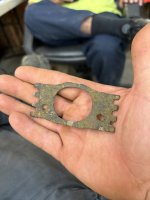jgowans
Full Member
Can anyone give me a breakdown of the coins posted on this site?
Since all I seem to find is clad and old rusted iron.
Why are some coins called Barber and what is the history behind them?
I have heard that where there are indians they may be silver? Why is that?
The coppers I have seen, are they really made of copper and what period where they made.
Does age equate to depth? What are the reasons for coins getting so deep? Vegetation? Gravity? Soil type?
I know, I should just go buy a coin book.......
But hey I crave human contact.
Thanks
JG
Since all I seem to find is clad and old rusted iron.
Why are some coins called Barber and what is the history behind them?
I have heard that where there are indians they may be silver? Why is that?
The coppers I have seen, are they really made of copper and what period where they made.
Does age equate to depth? What are the reasons for coins getting so deep? Vegetation? Gravity? Soil type?
I know, I should just go buy a coin book.......
But hey I crave human contact.
Thanks
JG






